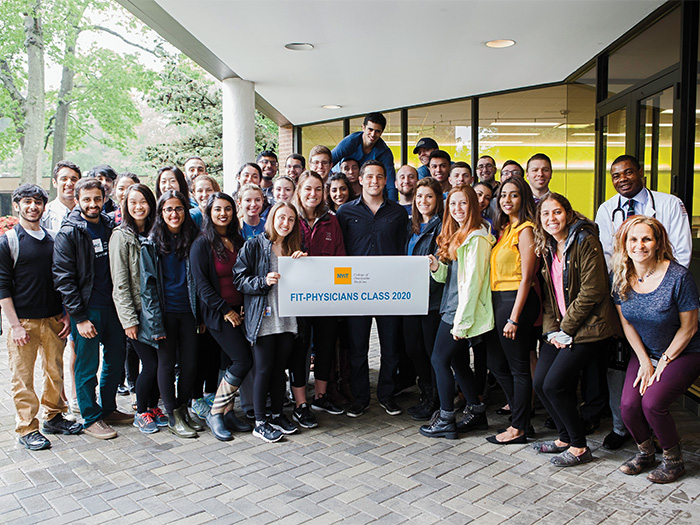News
Heal Thyself: Helping Students Fight Stress and Burnout
July 10, 2019
TOP PHOTO: Students sit on a bench along the Healing Path on the Long Island campus. The path provides spaces for reflection and decompression.
Taking good care of others doesn’t necessarily mean taking good care of yourself. Initiatives at NYIT take steps to combat the stress and burnout health providers experience early in their education.
It’s a difficult conundrum: students are attracted to medicine and the health professions out of a desire to promote wellness and help others, but the education and training involved often causes them high levels of stress and burnout. Without treatment, that stress can lead to serious results. Tragically, according to the American Association of Colleges of Osteopathic Medicine, an estimated 400 medical students, residents, and physicians take their own lives each year.
NYIT is not only focused on bringing awareness to this issue, but also offers health and wellness initiatives designed to support student mental health. “Doctors and health professionals know how to take care of others, but they sometimes neglect to take care of their own minds and bodies. You can’t really be good at healing others if you don’t take care of yourself first,” says Jerry Balentine, D.O., dean of the College of Osteopathic Medicine and NYIT vice president for health sciences and medical affairs. “We want to be a leader in promoting health and wellness for our students, our faculty members, our patients at the Riland Academic Health Care Center, and the patients of the future.”
Since joining NYIT in 2015, Balentine has made student wellness a priority. “It’s about the message we send to students,” he says. “If the school invests its resources in these efforts, they must be important. So we’re trying to model what’s important in our behavior, facilities, and research.”
We want to be a leader in promoting health and wellness for our students, our faculty members, our patients at the Riland Academic Health Care Center, and the patients of the future
Dean Jerry Balentine
Much of the stress from medical school comes from the sheer amount of information students are expected to learn. “When you’re expected to do two or three years of work in a semester, that’s going to stress just about everybody out,” says Carl Abraham, M.D., assistant professor of Clinical Medicine at NYITCOM-Arkansas.
Students in the School of Health Professions face similar academic demands as well as the pressure and responsibility of caring for others while they are still in the process of learning their field. As a result, many students in both schools find themselves struggling academically for the first time in their lives. On top of that, they worry about residencies and licensure exams and are burdened with loans.
The competition and fear of failing out results in students studying as much as 16 hours a day. “If you ask a medical student to choose between studying or doing something that’s healthy for themselves, students will always pick academics,” says Joanne Donoghue, Ph.D., assistant professor and director of clinical research.
The question is: How can NYIT help students lead healthier lives and meet their own high expectations?

Studies like Fit Physicians show the positive impact of physical activity on mental well-being.
Learning to be Well
Busy students often forgo exercise, skip meals, or develop unhealthy eating habits. Balentine wanted to address that. Shortly after joining NYIT, he initiated Run with the VP and Walk with the Dean, an informal mentoring and fitness program to help medical and health professions students focus on something besides their studies.
“We could see the positive effect it was having on the students,” says Donoghue, an avid triathlete who was recruited to run with the group. “So we decided to take it to the next level with a research study to actually measure the impact of the physical activity.”
During the 2016–2017 academic year, 124 medical students participated in the clinical trial, Fit Physician. Participants wore a Fitbit activity tracker alone and combined with an educational program. The study demonstrated that using wearable technology in conjunction with education and fitness challenges was an effective way to support physical activity and health outcome measures in medical students. (Results were presented at the 2017 American College of Sports Medicine conference and published in Preventive Medicine in September 2018.)
With support from the American Osteopathic Association (AOA), Donoghue launched a follow-up project to study the impact of physical activity on mental well-being. More than half of students said “working out” helped them cope with stress.
And physical activity is just one aspect of student wellness. Sleep, meditation, nutrition, and counseling are essential components to finding balance in mind and body—a fact reinforced by faculty research. For example, Bhuma Krishnamachari, Ph.D., associate professor and assistant dean of research, and Balentine have received funding from the AOA for a two-year study to see whether using the meditation app Headspace helps students increase empathy and reduce stress. A forthcoming project will use biometric measurement to study female stress. “We know from the literature that female medical students experience more stress than male medical students,” Krishnamachari says. “We’re trying to do an extensive project where we figure out exactly why.”
Nutrition also plays an important role. In 2017, Lorraine Mongiello, Dr.PH., RDN, associate professor of Interdisciplinary Health Sciences and Clinical Nutrition, and Mindy Haar, Ph.D., RDN, assistant dean of undergraduate affairs in the School of Health Professions and director of academic management, Interdisciplinary Health Sciences, launched the Garden Lecture Series, which includes classes on nutrition and the use of a garden on the Long Island campus.
“We have 10 modules that we hold right in the garden or the classroom right next to it,” says Haar, a clinical nutritionist. Topics range from diabetes and hypertension to “carb counting” and diets to the benefits of cooking with fresh herbs. “As future health professionals, our students are very interested in the mind-body connection. They also enjoy harvesting from the garden for their own use.”
Walking a Path to Wellness
Perhaps the most visible commitment to student wellness is the Healing Path, which winds around the iconic pond near the medical school. The student-led initiative, opened in 2017, leverages the beauty of the Long Island campus to create spaces for self-reflection and decompression.
“It’s an effort to shift the culture and destigmatize mental health issues as well as encourage people to be outdoors and not isolate themselves studying all the time,” says fourth-year medical student Matthew Goldfinger who spearheaded the effort with current third-year student Samantha Gottlieb and Alexander Nello (D.O. ’18).
Get a Good Night’s Sleep
Melanie Austin (B.S. ’00), O.T.D., M.P.A., is assistant professor of Occupational Therapy at the School of Health Professions and New York Tech’s Faculty Athletics Representative. With support of the NIH (National Institutes of Health) NHLBI Programs to Increase Diversity in Health-Related Research (PRIDE), she plans to study students’ perception of sleep. “Lack of quality sleep is an epidemic for young adults,” says Austin, who received training over the past two summers in the NYU Langone Behavioral and Sleep Medicine Institute. To identify how students and student-athletes perceive sleep and develop a culture to improve sleep, Austin is collaborating with students in New York Tech’s undergraduate computer science program to develop a sleep-related app. “We’re going to focus this initial prototype on what would motivate the user to make small changes in their routine,” she says. By improving sleep, she says, students can improve mental well-being and performance.
The Healing Path was funded with more than $100,000 in donations from the NYIT community, including a gift from Humayun Chaudhry (D.O. ’91), CEO of the Federation of State Medical Boards. “If [the path] improves the well-being of one future doctor, it’s worth every effort,” said Chaudhry when asked about his involvement in the project. Other major donors included NYIT Board of Trustee Daniel Ferrara (D.O. ’86) and Danielle Ferrara as well as Joshua Hourizadeh (D.O. ’10).
Psychiatrist Liat Jarkon (D.O. ’87), M.P.H., assistant professor in the Department of Family Medicine, agrees that efforts to help physicians can pay off. “While the suicide rate amongst medical professional is sobering, it’s not a mandate. We’re working diligently on promoting mental health awareness across our campus.” That includes educational events about mental health awareness and resources for faculty, staff, and students. “As a result, there will be more checks and balances in place so the community as a whole is more cognizant of the issue and can identify and reach out to those in need,” she says.
Both the Long Island and Arkansas locations are building on efforts to help students. “The idea is to build in some intentional time for decompression to help prevent student burnout,” says Nicole Wadsworth, D.O., site dean, NYITCOM (Long Island), and professor of Emergency Medicine. For example, in Arkansas, faculty mentors meet with students regularly. “We’re letting our students know that if they notice something wrong with a classmate, they need to speak up and not stand on the sideline. We’re all in this together,” says Abraham.
“The overarching goal is to provide students with the tools to deal with the stress that’s inherent in their profession, to learn to take care of themselves so they can best care for others,” adds Balentine. “That’s just as important as the science we’re teaching them; a very good professional school needs to emphasize both.”
Get a Good Night’s Sleep
Melanie Austin (B.S. ’00), O.T.D., M.P.A., is assistant professor of Occupational Therapy at the School of Health Professions and New York Tech’s Faculty Athletics Representative. With support of the NIH (National Institutes of Health) NHLBI Programs to Increase Diversity in Health-Related Research (PRIDE), she plans to study students’ perception of sleep. “Lack of quality sleep is an epidemic for young adults,” says Austin, who received training over the past two summers in the NYU Langone Behavioral and Sleep Medicine Institute. To identify how students and student-athletes perceive sleep and develop a culture to improve sleep, Austin is collaborating with students in New York Tech’s undergraduate computer science program to develop a sleep-related app. “We’re going to focus this initial prototype on what would motivate the user to make small changes in their routine,” she says. By improving sleep, she says, students can improve mental well-being and performance.
By Renee Levy




